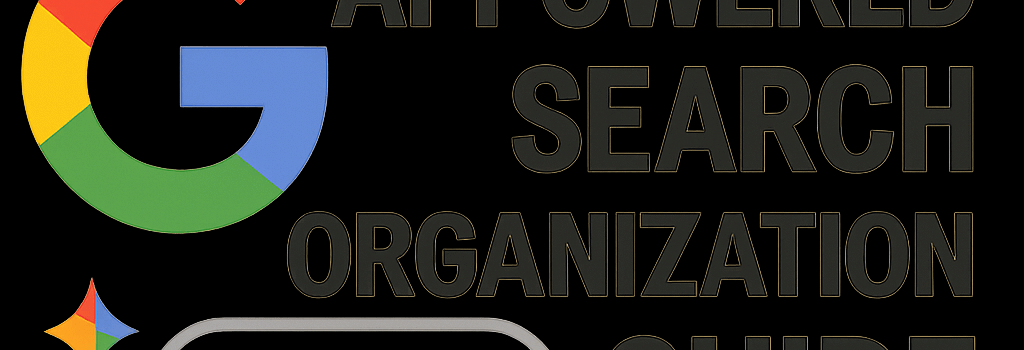Google’s AI-Powered Search Organization Guide

Google is rapidly evolving its core search product by layering generative AI features on top of the classic list of links. The latest preview, Web Guide, reimagines the search results page to intelligently organize and annotate links, summaries, and suggested topics—all powered by a custom version of Google’s Gemini model. Available today as an opt-in Search Labs feature, Web Guide sits between the familiar blue-link list and the full chatbot experience of AI Mode, promising users richer context without losing navigation control.
Key Features of Web Guide
- Structured Summaries: AI-generated headings group related results under thematic categories.
- Parallel Query Fan-Out: The system issues multiple sub-queries in parallel to surface diverse perspectives.
- Adaptive UX Toggle: A one-click switch lets users revert to the standard “Web” tab layout instantly.
How Web Guide Works
At its core, Web Guide leverages a custom-tailored Gemini instance with approximately 2 billion parameters, optimized for real-time inference. When a user enters an open-ended query—say, “how to solo travel in Japan”—Web Guide:
- Fan-Out Phase: Spawns six parallel searches focusing on topics such as budgeting, itineraries, and safety tips.
- Aggregation Phase: Consolidates top-ranked URLs from each sub-query using a proprietary relevance-scoring layer.
- Summarization Phase: Generates concise headings (50–80 characters) and 2–3 sentence summaries via a Retrieval-Augmented Generation (RAG) pipeline.
“Preliminary A/B tests show a 15% uplift in click-through rates when users engage with grouped content versus a flat list of links,” says Maria Chen, Senior Engineer on Google Search.
Technical Architecture of Web Guide
Multi-Query Fan-Out and Aggregation
Web Guide’s backbone is a distributed fan-out system running on Google’s internal TPU v5e clusters. Each sub-query is dispatched to regionally proximate endpoints for latency optimization, then results are merged in under 200 ms on average. A microservice orchestrator routes incoming queries, balances load, and handles fallbacks to standard search when GPU capacity is constrained.
RAG Summarization Pipeline
The summaries you see aren’t handcrafted templates but dynamically generated via a RAG pipeline combining:
- A semantic vector store built on BigTable for rapid content retrieval.
- Lightweight sequence-to-sequence decoders tuned on high-quality editorial data.
- An ensemble re-ranker that prunes hallucinations by cross-checking against the original source text.
Performance and Latency Considerations
Introducing AI organization inevitably adds computational overhead. Google estimates Web Guide adds approximately 300–400 ms to average search latency compared to traditional search. However, by leveraging edge TPU inference and caching strategies, the incremental delay is often imperceptible on modern desktops and 5G mobile connections.
- Cold Start: ~600 ms end-to-end (mobile network).
- Warm Cache: ~350 ms (desktop, fiber).
- Fallback: Instantly defaults back to the classic search results if GPU queues exceed thresholds.
Privacy and Security Implications
As with any generative AI system, privacy and data governance are front and center. Google asserts that:
- No user queries are used for training without explicit opt-in.
- Summaries reference URLs directly—minimizing the risk of misrepresentation.
- All processing occurs within Google’s secure data centers, encrypted in transit and at rest.
“We audit model outputs continuously to detect bias or content drift,” explains Priya Kumar, Privacy Lead for Search AI.
Future Directions and Industry Impact
Web Guide is currently limited to the “Web” tab in Search Labs, but Google plans to expand the experiment to the default “All” tab by Q4 2025, and integrate it with voice search on Android and ChromeOS. Industry observers note that Microsoft’s Bing Chat and Apple’s upcoming AI-powered Spotlight Search are moving in similar directions, heralding a broader shift toward AI-curated navigation.
Expert Opinions and User Feedback
Early adopters praise the contextual grouping but caution against overreliance on AI summaries. UX researcher Jane Doe warns: “Users appreciate guidance but still want transparency on how summaries are generated.” Google’s roadmap includes user-controlled transparency toggles to view source snippets alongside AI annotations.
Conclusion
Google’s Web Guide represents an evolutionary step in search UX—merging AI-driven context with the freedom of standard web navigation. As it matures, balancing performance, privacy, and editorial fidelity will determine whether it becomes the new default or remains an experimental side lane.